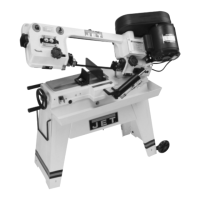19
Symptom Possible Cause Correction
Premature blade
dulling. (cont.)
Incorrect coolant or no coolant. Check with materials supplier and/or blade
supplier for coolant recommendations.
Check with coolant supplier for specific
recommendations on the blade and material
you are using.
Insufficient blade tension. Increase tension so blade is above the slipping
point.
Crooked cuts. Work not square. Adjust the right vise jaw so it is at right angles
to the blade.
Clamp work tightly in the vise.
Check blade for vertical and adjust, if
necessary.
Move guide bearings as close as possible to
work while still completing the cut.
Check guide bearings, seats and brackets for
possible looseness or wear.
Feed pressure too great. Observe chip formation to be sure cutting is
efficient.
Guide bearings not adjusted properly. Adjust guide bearings according to instructions
in this manual.
Inadequate blade tension. Increase blade tension so blade does not slip
on the wheels.
Blade guides incorrectly spaced. Move guide brackets until they just clear the
work piece while making a complete cut.
For small section pieces, be sure the blade is
sharp and correctly tensioned. Use less feed
pressure.
Dull blade. Replace blade when it dulls.
Consider using a coolant, if not already used.
Incorrect speed. Check technical literature for recommended
speeds and blade type for material being cut –
observe chip formation to verify efficient
cutting.
Blade guide assembly loose. Tighten guide bracket.
Blade guide bearing assembly loose. Check tightness of bearing seat bolt.
Blade tracking too far away from wheel
flanges.
Use paper cutting method of setting blade
tracking.
Worn upper wheel bearings. Replace bearings if worn.
Loose upper wheel mounting assembly. Tighten all bolts securing wheel to arm.
Rough cuts. Too much feed or speed. Try one step lower speed and observe chip
formation for efficient cutting/feed rate.
Blade too coarse. Use finer blade. Check with suppliers for
recommendations for the material you are
cutting.
Incorrect blade for material. Check with blade suppliers for
recommendations for exotic or unusual
materials or specifications.
Blade twisting.
Cut is binding blade. Be sure work piece is flat on saw base.
Decrease feed pressure.
Too much blade tension. Reduce tension to just above point where
blade slips.
Loose guide bearing eccentrics. Check eccentric jam nuts for tightness.
Worn guide bearings. Check guide bearings for wear. Replace if
necessary.

